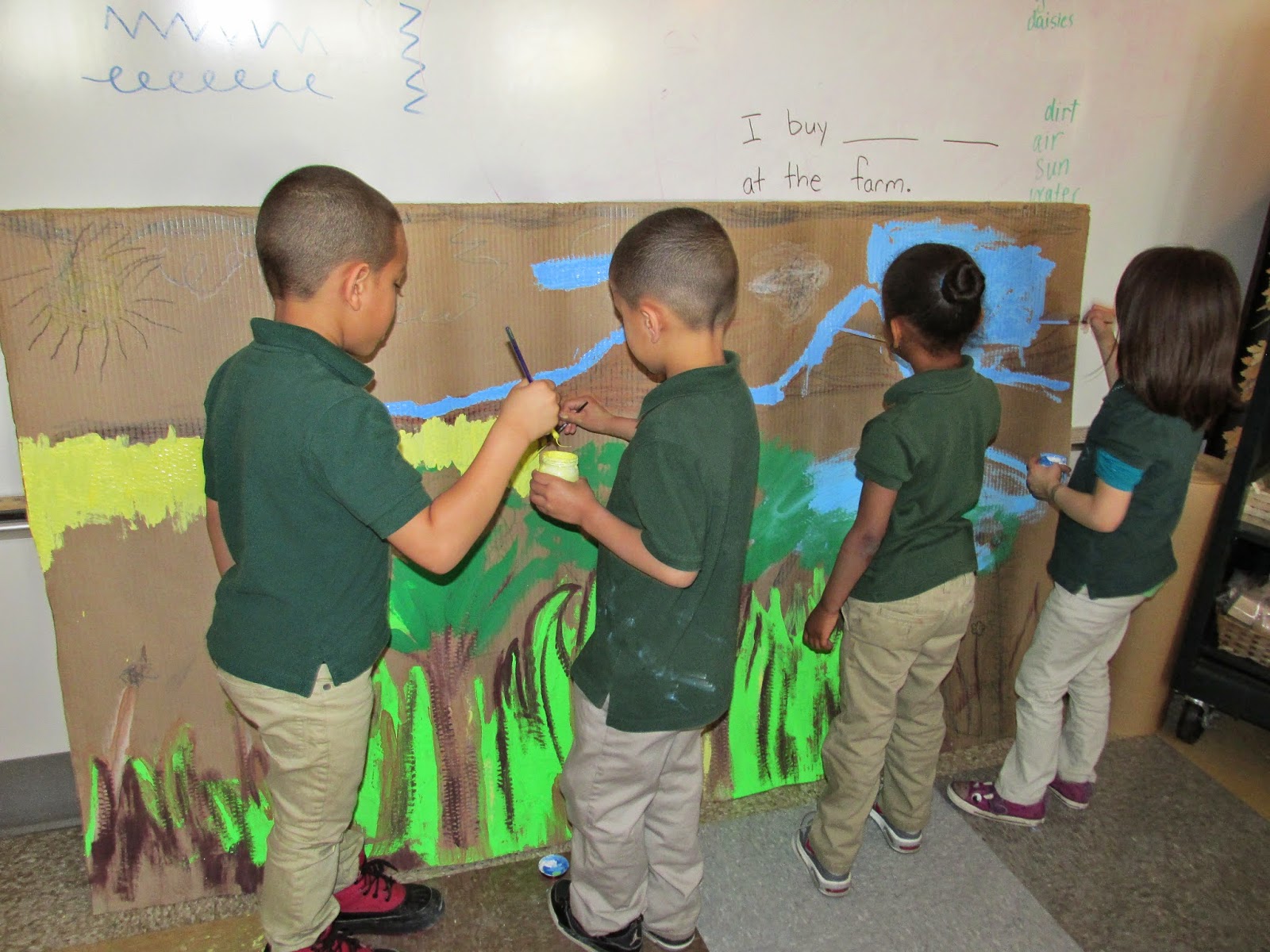Kindergarten: I've been using open studio time for the art show and meetings, so it's been good to get back into pulling small groups for the days. I brought a group into the studio today to create a background landscape for the life-sized horse they created after their trip to the farm. I thought this would take a few days, but they knew exactly what they wanted to do and had it ready in an hour! I'd previously taught them about horizon lines, so they drew that right away and started working on the grass and sky. They knew what colors to mix from the desert lesson and went right to work.
Brookelynn to Melangell- Go up and down, not side to side. It will look more
like grass that way. There you go. And be careful that you don't get it on your
pants or your mom will have to get the stain out.
Teacher- So what kind of animal might live in this environment?
Brooklynn- horses, chickens, sheep
Melangell- cows. There can also be chickens coming out on the
farm.
Brooklynn- what about chicks?
Melangell- chicks with their mama!
Brooklynn, singing- Chicks with their mama! Chicks with their mama! No,
chicks with their dad, because the mama has to go get all of the food.
Tell me more about the food.
Brooklynn- The chicks eat worms
Melangell- what do the cows eat? Oh yeah, grass!
Brooklynn- so do horses.
Melangell- horses do eat grass, and they eat hay
Brooklynn- I know that because I went to the farm with my mama
Melangell- and I went with my dad
Brooklynn- I stayed overnight for four days. No, four weeks.
Melangell- you would miss school if you stayed for that long.
Was it summertime?
Brooklynn- yeah, but my mom didn't like it because it was kind of cold
for her.
Brian joins them.
Melangell- you have to go up and down, like this.
Brian- I forgot!
Melangell- I went to a different farm.
Brian- I went to Cedar Point and I saw a zoo with tigers and
zebras.
Do tigers and zebras live at the farm?
Brian- Some zebras can live at a farm.
I think you are right about that. Do tigers?
Melangell- they live at the jungle
Brooklynn- in Africa
Brian- or at African lion safari
I pulled another kindergarten group in the afternoon who'd prepared a mural about the Savannah with their teacher. We critiqued the mural and looked at photographs to see what we needed to do next. The students started painting the grass and sky.
For second grade, I pulled a small group to continue our study of plants, as we prepare to begin a long unit on drawing and writing about plants. Two boys are very interested in the process of making paper out of trees. They watched a video about it, over and over again, pausing to read each line as it describes the process. They wanted to make a poster that explains the process, so that their friends could learn about it, too.
Pre- K continues to study the relationships between lines, pattern and animals. They reflected on the project thus far in this conversation:
Jacob- I see my Buffalo is brown.
Eziekiel- It looks like it's melted when we draw it three times. [This is referring to using glaze three times on the ceramic pieces, and the way it looked.]
Izabella- We looked at it and we drawed it.
Araceli- My fish has lines on the tail and that curvy line is his back and it looks like a fish and it's blue and yellow. It has lines and a curvy line going down and another curvy line on the tail. I love fishes. Sometimes fishes don't have curvy lines. Some have triangle lines. Some have "W" lines. Some have wiggly lines or lines that go down, down, down.
Ryan- I didn't know it had a nose! Some buffalos lines look like it goes like this. [shows the outline of a buffalo with his finger.]
Eziekiel- To do the lines, I needed to see it.
Izabella- A snake has curvy lines!
Today, I gave the students tiny close up photographs of animal skin and fur. The students looked closely at the lines and patterns. Ezekiel is really interested in looking at the lines now. He understands the need to slow down and look closely in order to draw what he sees.
Jacob is another student who is very interested in looking at the details. This is his drawing of the snakeskin:



















.jpg)






.JPG)







